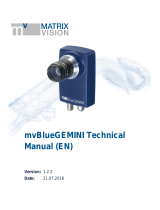
FRAGMENTATION AND REASSEMBLING
INTEGRATION GUIDE
13
Let's analyze the resynchronization process, starting from the previous data exchange
discussed in "Data Transmission from the device to PLC"…
1. PLC requests resynchronization by setting bit E = 1.
2. The device detects the request and so it resets IN[0].bit0 and IN[0].bit1. Then it
gives an acknowledge back to the PLC by means of bit F.
3. PLC has to reset OUT[0].bit0 and OUT[0].bit1 before completing its request with
bit E = 0.
4. The device completes the acknowledge process by setting bit F = 0.
5. Now Flow Control has been returned to a predefined state. All data exchange bits
in the Control Field are surely zero and data transmission can proceed safely.
FRAGMENTATION AND REASSEMBLING
The fragmentation process is activated whenever Application Data cannot be contained
in the related exchange area. Basically, long messages are split into pieces which are
transmitted separately. Reassembling allows the reconstruction of the whole messages.
The device already implements these functions in the DAD layer, while the PLC needs a
congruent management.
The fragmentation is based on the More Bit (bit 3) in the Control Field byte.
Input
Area
81Hex 00Hex 04Hex 41Hex 42Hex 43Hex 0DHe
x00Hex 00Hex 00Hex 00Hex 00Hex 00Hex 00Hex 00Hex 00Hex
Output
Area
81Hex 00Hex 00Hex 00Hex 00Hex 00Hex 00Hex 00Hex
Input
Area
81Hex 00Hex 04Hex 41Hex 42Hex 43Hex 0DHe
x00Hex 00Hex 00Hex 00Hex 00Hex 00Hex 00Hex 00Hex 00Hex
Output
Area
85He
x00Hex 00Hex 00Hex 00Hex 00Hex 00Hex 00Hex
Input
Area
84He
x00Hex 04Hex 41Hex 42Hex 43Hex 0DHe
x00Hex 00Hex 00Hex 00Hex 00Hex 00Hex 00Hex 00Hex 00Hex
Output
Area
85Hex 00Hex 00Hex 00Hex 00Hex 00Hex 00Hex 00Hex
Input
Area
84Hex 00Hex 04Hex 41Hex 42Hex 43Hex 0DHe
x00Hex 00Hex 00Hex 00Hex 00Hex 00Hex 00Hex 00Hex 00Hex
Output
Area
80He
x00Hex 00Hex 00Hex 00Hex 00Hex 00Hex 00Hex
Input
Area
80He
x00Hex 04Hex 41Hex 42Hex 43Hex 0DHe
x00Hex 00Hex 00Hex 00Hex 00Hex 00Hex 00Hex 00Hex 00Hex
Output
Area
80Hex 00Hex 00Hex 00Hex 00Hex 00Hex 00Hex 00Hex





















